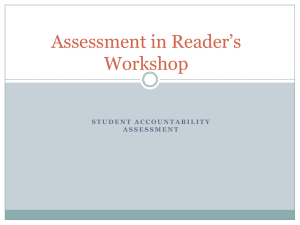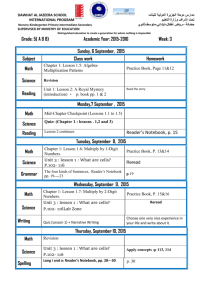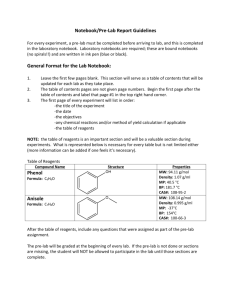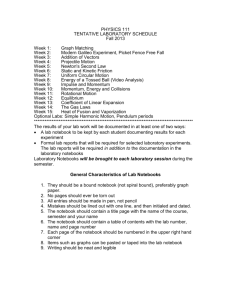Introduction to the Physics 211 Laboratory
advertisement
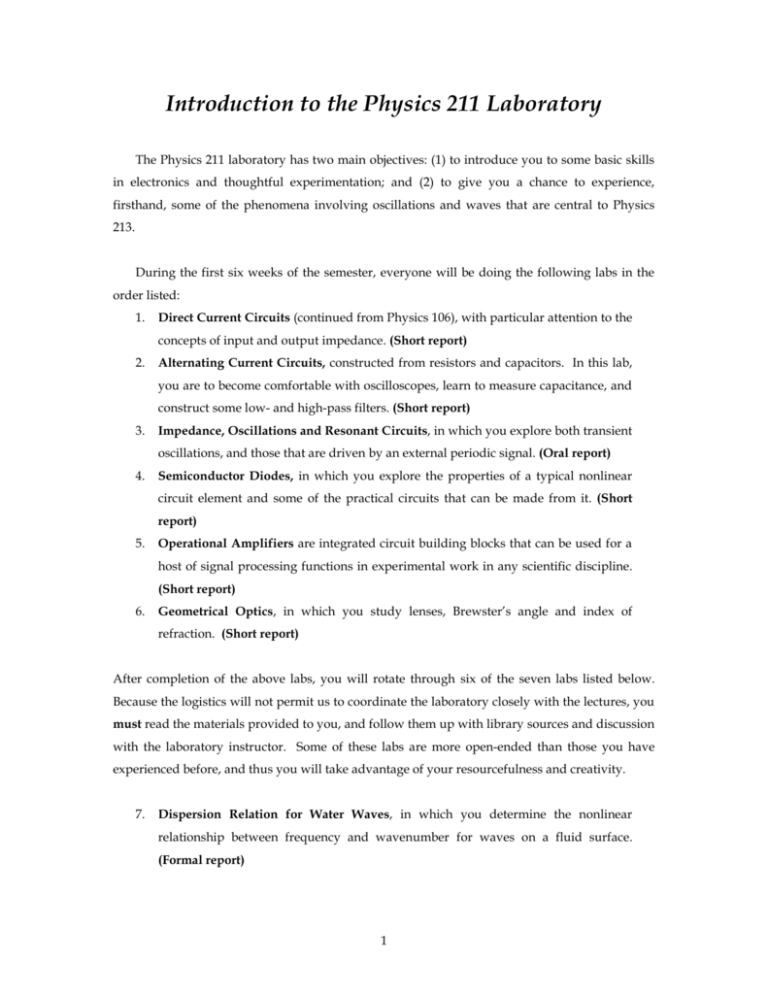
Introduction to the Physics 211 Laboratory The Physics 211 laboratory has two main objectives: (1) to introduce you to some basic skills in electronics and thoughtful experimentation; and (2) to give you a chance to experience, firsthand, some of the phenomena involving oscillations and waves that are central to Physics 213. During the first six weeks of the semester, everyone will be doing the following labs in the order listed: 1. Direct Current Circuits (continued from Physics 106), with particular attention to the concepts of input and output impedance. (Short report) 2. Alternating Current Circuits, constructed from resistors and capacitors. In this lab, you are to become comfortable with oscilloscopes, learn to measure capacitance, and construct some low- and high-pass filters. (Short report) 3. Impedance, Oscillations and Resonant Circuits, in which you explore both transient oscillations, and those that are driven by an external periodic signal. (Oral report) 4. Semiconductor Diodes, in which you explore the properties of a typical nonlinear circuit element and some of the practical circuits that can be made from it. (Short report) 5. Operational Amplifiers are integrated circuit building blocks that can be used for a host of signal processing functions in experimental work in any scientific discipline. (Short report) 6. Geometrical Optics, in which you study lenses, Brewster’s angle and index of refraction. (Short report) After completion of the above labs, you will rotate through six of the seven labs listed below. Because the logistics will not permit us to coordinate the laboratory closely with the lectures, you must read the materials provided to you, and follow them up with library sources and discussion with the laboratory instructor. Some of these labs are more open-ended than those you have experienced before, and thus you will take advantage of your resourcefulness and creativity. 7. Dispersion Relation for Water Waves, in which you determine the nonlinear relationship between frequency and wavenumber for waves on a fluid surface. (Formal report) 1 2 Introduction 8. Ultrasound Imaging: Here you learn about the physics of ultrasound (high frequency sound) and use it to image the interior of objects that are not transparent to light. (Oral report) 9. Non-linear oscillations involves the study of a chaotic system. (Formal report) 10. Abbe Theory of Imaging & Physical Optics, in which you will analyze images in terms of spatial frequencies. (Oral report) 11. Optical instruments, in which you will construct telescopes and examine the physical characteristics of the eye. (Short report) 12. Resonance and Normal Modes. (Short report) LAB REQUIREMENTS: You are expected to prepare before coming to lab, by reading the materials provided and answering any pre-lab questions that are contained in them. Hand in your clear and coherent answers to the pre-lab questions at the beginning of the lab period. If you need help with these questions, feel free to ask the instructors—before the lab period! Attendance is required at each lab period. Please send e-mail to samador or sshelley in advance if you need to miss a lab. NOTE: Athletic absences if any should be arranged at the beginning of the semester. LAB NOTEBOOKS: You must have a lab notebook for use during lab. We recommend a ring binder that allows material to be inserted or rearranged. (This would not be allowed in an industrial research lab where non-modifiable records are required for patent applications.) For each lab, your notebook should contain: 1. Answers to the Pre-Lab questions posed in the lab manual. These must be done (or at least attempted) prior to lab. If done afterwards, this fact should be noted in the notebook! 2. To the extent that what you did in lab differed from what was described in the lab manual, give a brief summary of what you did, including circuit diagrams for electronics experiments. 3. Data (or observations) obtained during lab in its original form (may not be changed or re-written later, but may be photocopied from your partner). EACH ITEM SHOULD HAVE A BRIEF TITLE SO IT IS CLEAR WHAT EXPERIMENT IS BEING DONE. 4. Answers to (or discussions of) all of the underlined questions posed in the lab manual, including data analysis and graphs with appropriate estimates of uncertainties. Some of this material may be written after lab. (Not necessary for oral or Formal reports). Introduction 5. 3 Any additional comments you think should be added, for example to address the conceptual issues posed by the experiment. This material should be completed by the start of following lab session, i.e., on the day you are scheduled to begin work on the next lab. It is fine to put a line through material in your notebook that you have later decided is incorrect. Scratch work and informal notes that the instructor should ignore can be placed in the back of the book. We do not intend reporting on your work to be burdensome. Our general hope is to focus your attention on the work in lab, and to limit the writing to the amount required for us to judge the quality of your work and understanding. You need not repeat material that is contained in the lab manual. LAB REPORTS: For many experiments, a photocopy of the material described under “Lab Notebooks” will suffice. However, your work on certain experiments will be evaluated by means of formal written reports or oral discussion reports. Formal written reports: You are asked to write formal written reports (described below) on the Non-linear Oscillator and Dispersion Relation for Water Waves experiments. You and your lab partner should analyze the data together but write your reports independently. The report is due at the start of lab on the second Thursday following the completion of this lab (since the formal report will require more time than usual). For these experiments, your notebooks need contain only the pre-lab questions and the original data, since the report contains everything else. Oral discussion reports: We will have informal oral discussion reports on: Impedance, Oscillations and Resonant Circuits, Ultrasound Imaging and Abbe Theory of Light. For these, you and your partner will again analyze the data together. You will then have informal joint discussions with Suzanne Amador Kane or Scott Shelley about your work (by appointment). You should bring your results and graphs with you to this session, but you need not discuss the results in your lab notebook (since we will do so together). Previous students have found these to be very useful teaching-learning sessions. EXTENSIONS: For lab notebook reports, or formal reports, each student is permitted one oneweek extension with no loss of credit. Hand in or e-mail your extension requests on the regular due date. Save the extension for when you really need it, and don't fall behind on the following lab! Aside from this extension, materials or reports turned in late will be subject to a penalty of 10% (about one grade point) per week. 4 Introduction All work must be turned in by the College deadline, Friday, December 19th 2008. (Sorry, no extensions to this deadline can be given without approval from the student’s Dean.) HONOR CODE: You will work with a partner in the lab. Each student should prepare for the lab independently, but you may consult with your partner, another student, or an instructor if you can't answer a pre-lab question. During lab, it is OK if one person is the primary note taker and provides a photocopy of data for the other partner's notebook (assuming that both participated fully). However, any subsequent writing for the notebooks or for individual reports should be done independently. Physics 211 Formal Lab Reports ADVICE ON FORMAL REPORTS: Your formal written report should utilize a format similar to the standard format of scientific papers. It should have the following major sections. Abstract: In one or two short paragraphs, summarize the experiment and results. State what was measured or determined and by what method. Be sure to give the results quantitatively (with uncertainty) where appropriate. The purpose of an abstract is to provide readers of a journal (or attendees of a conference where many papers are presented) a convenient means of learning the significance of any particular paper without having to read the whole paper. The readers will then decide which papers to read based on the abstracts. So, think of the abstract as an advertisement for your paper. Imagine that you are a professional scientist and are publishing your paper in a journal, and keep the following in mind: a) You want to be sure that people read the abstract--so make it short. b) The one thing you absolutely want everyone to know, even those who don't read the paper, is your main result (or results). Do not think of your paper as a mystery novel where you might avoid telling the reader your result. If you don't state any results in your abstract, the readers will think that you have no result (that the paper only discusses an attempt to get a result) and may not bother reading your paper. If you state the result, then even those who don't read the paper will at least know of your accomplishments...and that is your main goal in publishing the paper. Introduction and Background: Here, you summarize what has been done, and put it in the context of related theoretical work or previous experiments. Try writing this section last, based Introduction 5 on an outline devised while writing the other sections. That way, you will know what you need to mention. Consider the introduction (one to two paragraphs) as the motivator—use this section to impress upon your readers the importance or significance of the experiment. For example: “Microwaves are a form of electromagnetic radiation. Therefore, they should exhibit all of the phenomena of geometrical and physical optics. However, their relatively long wavelength (a few centimeters) can have important consequences. In this experiment, we have investigated some of these phenomena, including..." Note that at the end of the introduction, you should actually indicate (briefly) what has been done. Do not be afraid to give your answer (or answers, if there are multiple results) prematurely. Readers will find your paper easier to read if they know where it is headed. The background is a brief summary of the theory related to your measurements. (In a real paper, you would also discuss previous measurements.) Keep this section brief, and give references to other sources. (The references are intended to be helpful to the reader, and they also give proper credit to others.) If the background material is long, you might split the "Introduction and Background" into two separate sections. Experimental Methods: The purpose of this section is to inform the reader of the method well enough so that the reader can establish an informed opinion of its reliability. For example, in the cold nuclear fusion announcement, the details of the method were not communicated, so many scientists were alerted to be skeptical. Properly educated scientists will not believe a result until they learn enough of the experimental method used to feel confident that it was reliable. Do not restate the specific instructions in the lab handouts. For example, do not give unimportant details, such as where a particular switch is or how you place your head to see that something is aligned. Instead summarize the methodology, using a diagram if appropriate, in a way that would allow an intelligent scientist to understand what you have done. Also explain the method by which the uncertainty in the measurements has been assessed. (Separate measurements may be needed to estimate the measurement uncertainty.) In some cases, this can be quite brief. However, if a precision measurement has been made, as in the Refractive Index experiment, you should explain carefully how uncertainties were estimated. Results: Here you fully describe the results of your experiments. Use figures and tables generously. Assign a number to each figure or table (i.e. figure 1,2,3; table 1,2,3), and discuss each one in the text. Each figure or table should also have a brief explanatory caption so that its main point can be grasped independently of the text. 6 Introduction Be sure to include an estimated uncertainty with every significant measurement. If systematic errors (rather than statistical uncertainty) could also be significant, they should also be discussed. One very common mistake is to calculate the percentage difference between the measurement and an accepted value and to call this the measurement uncertainty. The measurement uncertainty is to be determined without reference to any assumed correct value. By calling the error in your result the amount that it differs from an accepted value, you are essentially stating a) that the correct answer has been determined, so your experiment is completely pointless, and b) that you know that your answer is the wrong one, and therefore no reader should pay any attention to it. Furthermore, a physicist does not generally know what the correct answer to an experiment is, yet still wants to know how accurate the determined value is. You can (and often should), however, discuss any disagreement between your result and the theoretical prediction, and indicate whether the disagreement is significant in view of the estimated uncertainty. Discussion and Conclusion: This section includes both a restatement of the main results, and a thoughtful discussion of their significance. It differs from the abstract in several ways. First, it is generally longer. Second, it is more reflective, and you can include speculations or suggestions for further work. The restatement may seem redundant. However, especially if there are a number of different results in your paper, the summary at the end can be helpful to the reader. Many readers will read this section first, and only afterwards read the earlier parts of the paper. One last piece of advice: write the report honestly—don't try to oversell your results. If the results are only marginally significant, you are better off being clear in the paper that you believe this to be the case. Others may still find it interesting enough and follow up on your experiment. Overselling the results is dangerous to your reputation as a scientist and displays a disregard for scientific integrity. Before turning in your report, run a spell check, and also read it over for grammatical errors! Make sure that the point of each paragraph is clear, and prune wordy sentences. In other words, show off your talents as writers. You want the reader to have confidence in your work; meticulous presentation and careful writing can help. Technical points to check: Use proper abbreviations of units. No equations in the abstract; Use Word’s equation formatter for the body of the report. Introduction 7 All symbols should be defined when first introduced. Use superscripts to refer to numbered references at the end of the report. Order of assembly: abstract; body of report; references; captions (if not on the figures); tables; figures. Scott Shelley September 9th, 2008
